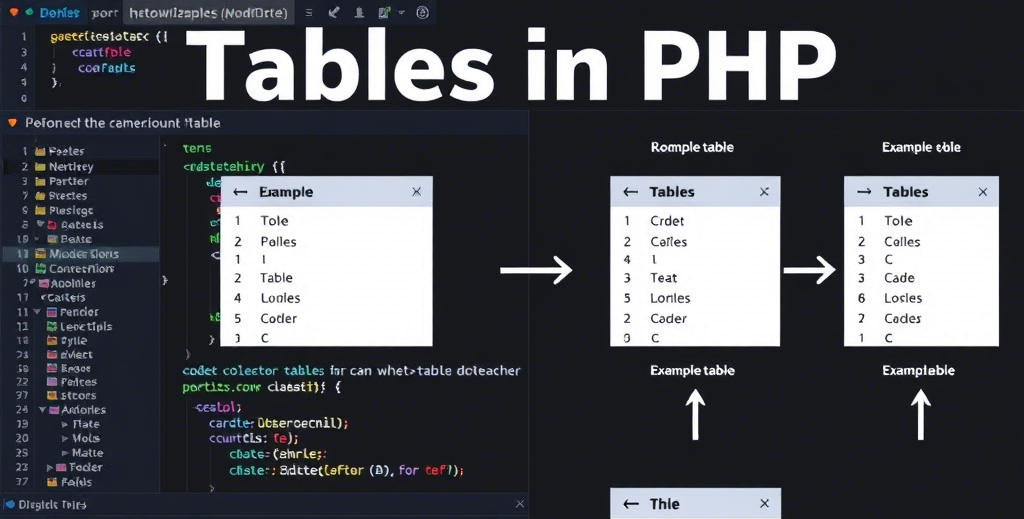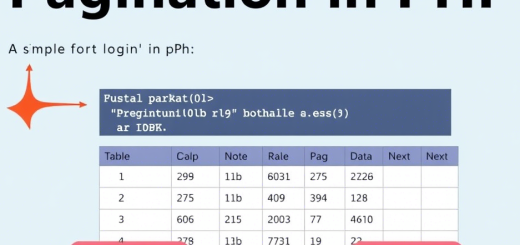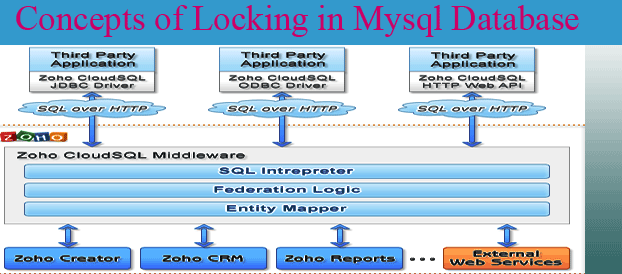Tables in PHP: A Comprehensive Guide
Tables are a fundamental aspect of web development, especially when dealing with structured data. PHP, combined with MySQL and HTML, provides an excellent framework for creating, managing, and displaying data in tables. In this blog, we’ll cover:
- How to use
GETandPOSTmethods in PHP. - Creating and managing tables in MySQL.
- Displaying data in HTML tables using PHP.

Understanding GET and POST Methods
GET and POST are the two most common HTTP methods used for transferring data between a client and a server.
GET Method:
- Sends data through the URL.
- Ideal for requests where data is not sensitive (e.g., search queries).
- Limited by the URL length.
Example:
<?php
if (isset($_GET['name'])) {
$name = $_GET['name'];
echo "Hello, " . htmlspecialchars($name);
}
?>
<!-- HTML -->
<form method="GET">
<label for="name">Enter your name:</label>
<input type="text" id="name" name="name">
<button type="submit">Submit</button>
</form>
POST Method:
- Sends data through the HTTP request body.
- More secure for sensitive data (e.g., passwords).
- No URL length limitations.
Example:
<?php
if ($_SERVER['REQUEST_METHOD'] == 'POST' && isset($_POST['email'])) {
$email = $_POST['email'];
echo "Your email is: " . htmlspecialchars($email);
}
?>
<!-- HTML -->
<form method="POST">
<label for="email">Enter your email:</label>
<input type="email" id="email" name="email">
<button type="submit">Submit</button>
</form>
Creating and Managing Tables in MySQL
MySQL tables store data in a structured format. Each table consists of rows and columns.
Creating a Table:
SQL Query:
CREATE TABLE users (
id INT AUTO_INCREMENT PRIMARY KEY,
name VARCHAR(100),
email VARCHAR(100),
age INT
);
Inserting Data:
SQL Query:
INSERT INTO users (name, email, age) VALUES
('Alice', '[email protected]', 25),
('Bob', '[email protected]', 30),
('Charlie', '[email protected]', 35);
Fetching Data:
SQL Query:
SELECT * FROM users;
Displaying Data in HTML Tables Using PHP
To display data stored in a MySQL table, use PHP to fetch the data and dynamically generate an HTML table.
Example:
PHP Code:
<?php
include 'db.php';
$query = "SELECT * FROM users";
$result = $conn->query($query);
?>
<!DOCTYPE html>
<html lang="en">
<head>
<meta charset="UTF-8">
<meta name="viewport" content="width=device-width, initial-scale=1.0">
<title>Users Table</title>
</head>
<body>
<h1>Users List</h1>
<table border="1">
<tr>
<th>ID</th>
<th>Name</th>
<th>Email</th>
<th>Age</th>
</tr>
<?php while ($row = $result->fetch_assoc()) : ?>
<tr>
<td><?php echo $row['id']; ?></td>
<td><?php echo $row['name']; ?></td>
<td><?php echo $row['email']; ?></td>
<td><?php echo $row['age']; ?></td>
</tr>
<?php endwhile; ?>
</table>
</body>
</html>
Explanation:
- Database Connection: Connect to the MySQL database using a
db.phpfile. - Query Execution: Use
SELECTto fetch data from theuserstable. - Dynamic Table Creation: Use PHP loops to populate table rows with data.
Combining GET and POST with Tables
You can enhance user interaction by integrating GET and POST methods with tables. For example, creating a form to filter data:
Filter Example:
<?php
if ($_SERVER['REQUEST_METHOD'] == 'POST' && isset($_POST['age_filter'])) {
$age_filter = (int) $_POST['age_filter'];
$query = "SELECT * FROM users WHERE age >= $age_filter";
} else {
$query = "SELECT * FROM users";
}
$result = $conn->query($query);
?>
<form method="POST">
<label for="age_filter">Filter by Age (>=):</label>
<input type="number" id="age_filter" name="age_filter">
<button type="submit">Filter</button>
</form>
<table border="1">
<tr>
<th>ID</th>
<th>Name</th>
<th>Email</th>
<th>Age</th>
</tr>
<?php while ($row = $result->fetch_assoc()) : ?>
<tr>
<td><?php echo $row['id']; ?></td>
<td><?php echo $row['name']; ?></td>
<td><?php echo $row['email']; ?></td>
<td><?php echo $row['age']; ?></td>
</tr>
<?php endwhile; ?>
</table>
Conclusion
Tables are an essential part of web development for managing and displaying data. By understanding the GET and POST methods, creating tables in MySQL, and dynamically displaying them in HTML using PHP, you can build powerful, data-driven web applications.
Kushagra Kumar Mishra
Latest posts by Kushagra Kumar Mishra (see all)
- Advanced WordPress Topics: Security, Performance, and Scalability (Part-2) - March 10, 2025
- Troubleshooting and Advanced Topics Part-1 - March 10, 2025
- Website Design and Development - March 10, 2025





Recent Comments